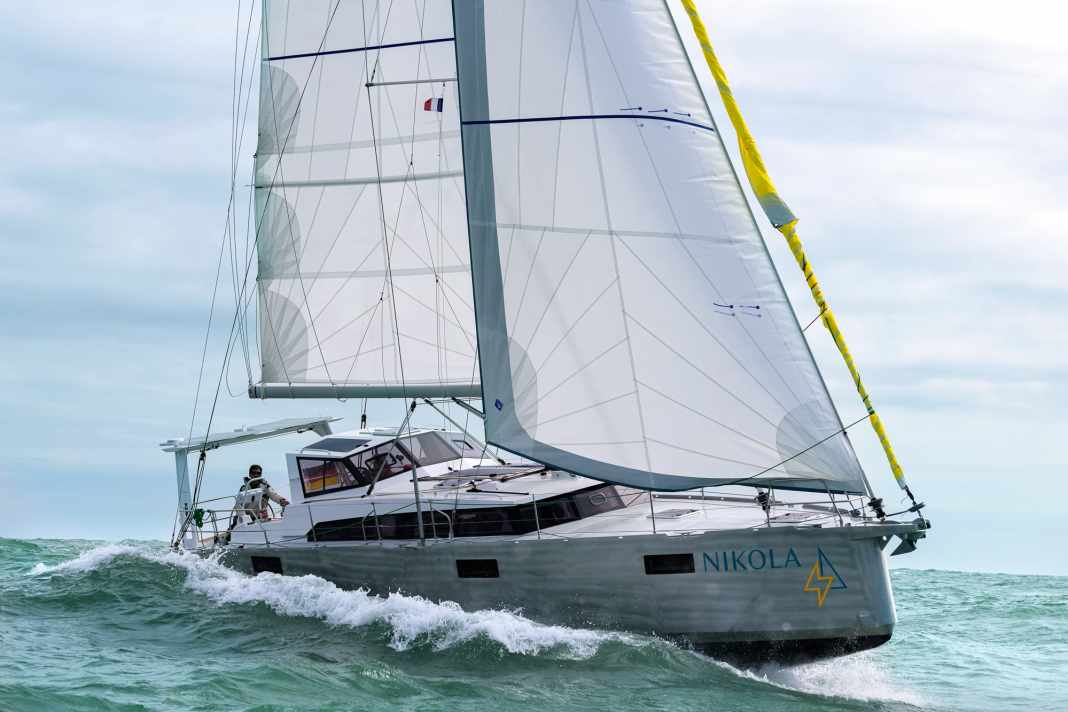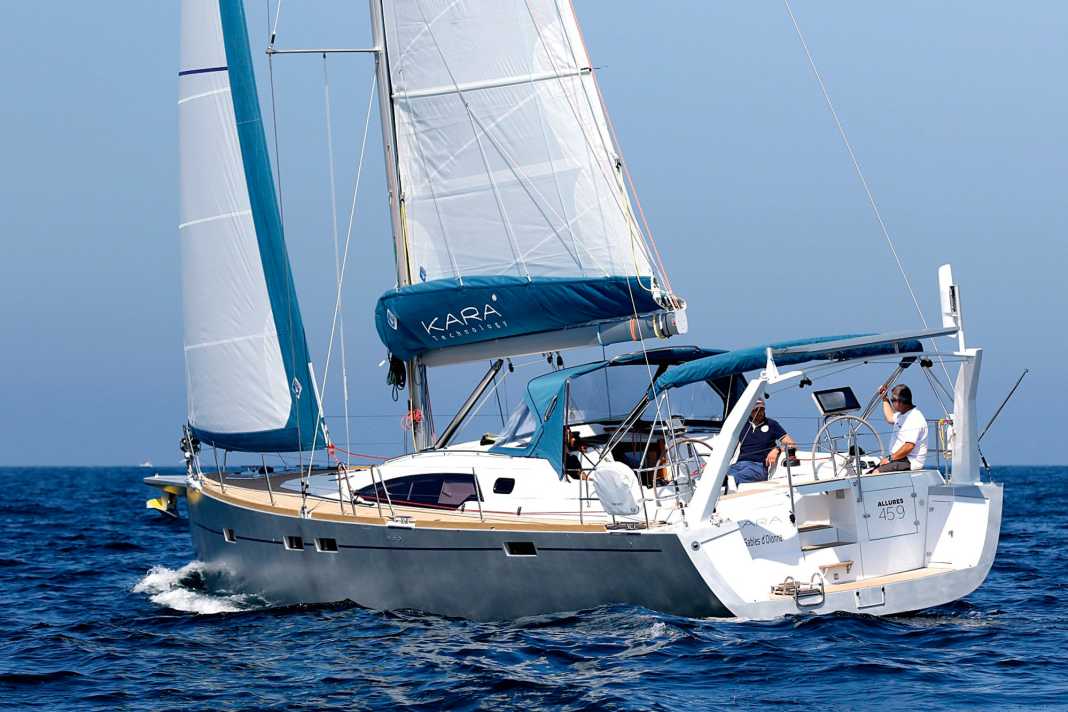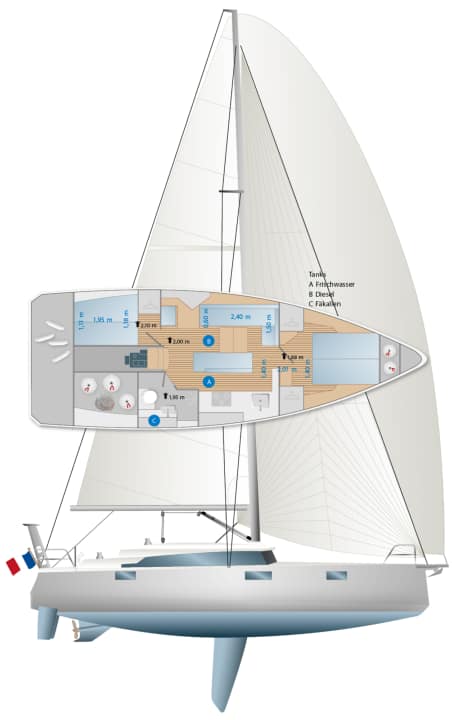





For the young family of three from Germany, it is to be the trip of a lifetime. A break from everyday life for several years, even before the children have to go to school. They have prepared long and hard, worked out possible routes and trained diligently for the adventure on the high seas around the globe. Now, just recently, the mooring lines of the "Nikola" have been cast off in Les Sables-d'Olonne. The neo-adventurers want to record their experiences in an internet blog - just like many blue water sailors do.
Their home for the next few years is a brand new Ovni 430 aluminium yacht, construction number two from the recently launched series. The Alubat shipyard currently has 22 orders on its books for the new model. This is a great success for the traditional shipyard in Les Sables-d'Olonne and in particular for Luc Jurien, the new owner of the brand and managing director of the shipyard, who can look back on a wealth of blue water experience. The Ovni 430 is a further development of the Ovni 400which was launched on the market just over four years ago (test YACHT 3/2020). With the type designation 430, the shipyard suggests a larger ship, which it is not at all. With a hull length of 12.30 metres, the new boat in the Ovni series is only just two centimetres longer than its predecessor model, or just over 40 feet.
But that's not the point at all. Rather, Alubat has fundamentally revised the design in collaboration with the architects from Mortain & Mavrikios and also involved the designers from Jean-Pierre Brouns' CBA Design Office, who were also involved in the development of the smaller sister model. Ovni 370 (Test YACHT 6/2022) were significantly involved. Alubat traditionally builds its ships as multi-buckling frames made from aluminium plates of different thicknesses, which are welded together over a frame and along the entire length of the ship.
There are many robust ocean-going yachts made of aluminium: a compact overview





While the hull of the Ovni 400 was still made from five panels, the shipyard has reverted to a seven-panel design for the new 430, as was previously the case for the older models in the Ovni range. Although this means more work in production, it also allows the use of slightly thinner aluminium panels, which saves weight. Above all, however, it gives the shipyard more freedom in the design of the hull, which in the Ovni 430 is significantly more voluminous and rounder in shape than its predecessor, particularly in the foredeck area. Curves are generally a major challenge when building aluminium yachts.
Another new feature is that the base plate now remains completely flat and no longer has an implied long keel. On the other hand, the keel step is generally somewhat more pronounced. Like all Ovnis, the new 430 also has an integral swing keel that can be fully retracted into the hull. With this and the flat bottom, the Ovni can dry out almost anywhere, even regularly in tidal waters. In the new boat, the ballast centreboard is now made of cast iron rather than aluminium. In addition, the fin is now moulded with a NACA profile to optimise flow and buoyancy. And it is now only moved via the winch using strong talc pulls and no longer via a hydraulic system, which makes it easier to operate physically, but is also vulnerable, maintenance-intensive and expensive.
Additional stability is provided by the internal ballast in the form of cast iron blocks, which are installed in the hull at a maximum depth. Together, the ballast bodies weigh around 2.5 tonnes and are cast in resin in permanently installed aluminium boxes in the bilge. It goes without saying that the shipyard also ensures strict separation of the different metals in order to avoid the dreaded electrolysis. As standard, the hull is insulated above the waterline with cold foam panels.
If you want to steer high with the sails furled as tightly as possible, you will quickly have to accept a significant drop in performance
With the standard sails (main and genoa), the sail load factor (sail area to weight ratio) is a low 4.0, which makes the Ovni 430 a pure cruising boat with only modest performance potential. Rather, the Ovni concept is geared towards long strokes and safe progress.
The test with the "Nikola" off Les Sables-d'Olonne proves difficult behind a receding storm front. While the wind is only blowing moderately at between 12 and 15 knots (approx. 4 Beaufort), a substantial swell of two to three metres remains.
The test with the predecessor model Ovni 400 has already shown that the Mortain & Mavrikios design copes better with lightly shrouded sheets on a deeper course than very hard upwind. The new boat is no different. If you want to steer high with the sails hoisted as close as possible, you will quickly have to accept a significant drop in performance. Ideally, the boat runs on a course of around 50 degrees to the true wind direction and achieves a solid 6.5 knots of speed.
The visually rather sedate-looking Frenchwoman also surprises with solid steering characteristics and good dynamics, both upwind and downwind with the gennaker unfurled, where the ship can even break the ten-knot mark with a little wave support.
For the interior of the Ovni 430, Alubat has adopted the layout of the predecessor model 400 with only minor visual adjustments
On the predecessor Ovni 400, a tarpaulin bracket above the cockpit was standard, with the great advantage of good and efficient trimmability of the mainsail. The disadvantage: the solid aluminium frame is heavy and raises the centre of gravity, which is not at all desirable, especially for blue water yachts with an integral centreboard and internal ballast. This is why Alubat has dispensed with the tare bar in the cockpit design of the 430. The buyer can order a wide-span sprayhood or have the boat built with a fixed doghouse for good protection on long journeys, as was the case with the test boat.
However, this relegates the mainsheet guide very far forwards, with attachment points on the coachroof. As this means that the sheet pull engages well in front of the centre of the main boom, the loads increase, and even in medium wind forces, it is only possible to haul tight with a great deal of effort. This is not the only reason why the optionally available winches with electric drives on the companionway are recommended. In contrast, the genoa winches, which are integrated into the massive steering pedestals, are relaxed, safe and effective when working from the cockpit. The helmsman can row without restriction and trim the headsail at the same time.
For the interior of the Ovni 430, Alubat has adopted the layout of the predecessor model 400 with only minor visual adjustments. One new feature, however, is that the seating area in the saloon can now be raised by around half a metre. This turns the ship into a deck saloon yacht if desired. The all-round window strip then ensures an almost unrestricted all-round view, even when seated. The owners of the test ship, on the other hand, opted for the standard extension without elevation for their long blue water voyage. In both cases, however, the navigation is installed at a higher level. Here, you can see through the windows while seated and can also steer the boat from inside using the autopilot remote control.
It is also possible to add two additional Pullman berths for family sailors
Due to the central box for the retractable ballast centreboard, the galley on the starboard side is built as one row to the side of the saloon. There is no alternative to this. This layout may not be ideal on long trips, as you can't wedge yourself into the galley for work and have little support. On the other hand, the functionality of the galley benefits thanks to the ample storage space and the many storage compartments.
There are different conversion options for the starboard side aft. The space can be converted into a large forecastle for blue water sailors or a workshop with flawless access to the 80 centimetre wide technical channel in the centre, where a sufficiently large generator and a water maker can be installed. It is also possible to add two additional Pullman berths for family sailing. In this case, however, access is only possible through the spacious heads compartment. The aft cabin on the port side offers a high level of living comfort, but only for one person. With a width of 1.18 metres at the shoulders, the berth is too narrow for double occupancy.
Many ocean-going yachts made of aluminium are significantly larger than the Ovni, but also significantly more expensive
The fitting-out standard for the owner's cabin in the foredeck provides for a rectangular island bed with a continuous width of 1.40 metres. These dimensions only just fulfil the minimum requirements for two people. The owners of the test ship had the shipyard install a large triangular berth with an impressive width of 2.30 metres at the shoulders. In general, Alubat is open to special requests of this kind.
The Ovni 430 costs not quite 620,000 euros gross with comprehensive and high-quality basic equipment including sails. The price is difficult to classify because there are hardly any comparable competitor boats in this length class. Many ocean-going yachts made of aluminium are significantly larger than the Ovni, but also significantly more expensive.
Sailors with a longing for faraway places will find numerous offers for robust blue water yachts on the market. However, if you are looking for a boat in a handy, manageable format and want to play it safe at the same time, then the yachts in the Ovni range should also be on your list.
The measured values for testing the Ovni 430





The Ovni 430 in detail

Technical data of the Ovni 430
- Designer: Mortain & Mavrikios/CBA
- CE design category: A
- Torso length: 12,30 m
- Total length: 12,95 m
- Waterline length: 11,60 m
- Width: 4,36 m
- Draught/alternative: 0,98-3,45 m
- Mast height above WL: 18,55 m
- Theor. torso speed: 8.3 kn
- Weight: 11,9 t
- Ballast/proportion: 4,0 t/33,6 %
- Mainsail (Std.): 44,0 m2
- Furling genoa (Solent): 41,0 m2
- machine (Volvo P.): 36.5 kW/50 hp
- Fuel tank (PVC): 580 l
- Fresh water tank (PVC): 450 l
- Holding tank (PVC): 50 l
- Batteries (service): 3x 90 Ah (AGM)
Hull and deck construction
Aluminium construction welded over a frame. Hull built in multi-buckling frame with seven plates (8/10 mm). Deck and superstructure made of aluminium (6 mm), cockpit tub aluminium (4 mm)
Equipment and prices
- Base price ex shipyard: 618.800 €
- Standard equipment included: engine, sails, sheets, railing, navigation lights, battery, compass, cushions, galley/cooker, bilge pump, toilet, sailcloth, fire extinguisher, electric cooler, holding tank with suction, antifouling paint
- For an extra charge: Anchor with chain (bow and stern anchor) € 4,250, fender/mooring line € 1,525, clear sailing handover € 10,185
- Price ready to sail: 634.760 €
- General guarantee: 2 years
How the prices shown are defined can be found here!
Surcharge for comfort equipment
- Hole points: incl.
- Traveller: not available
- Electric windlass: incl.
- Tube kicker: incl.
- Backstay tensioner: not available
- Jumping cleats: incl.
- Sprayhood: 6.585 €
- Teak in the cockpit: incl.
- VHF radio: E-package
- Log and echo sounder: E-package
- Wind measuring system: E-package
- Autopilot: E-package
- Electrical package: 27.735 €
- Charger: incl.
- Shore connection with RCD: incl.
- 230 volt socket (one): incl.
- 12-volt socket in the sat nav: incl.
- Heating: 12.080 €
- Pressurised water system: incl.
- Hot water boiler: incl.
- Shower WC room: incl.
- Cockpit shower: incl.
- Comfort price : 681.160 €
Included in the price:
Cockpit table, equipment carrier at the stern, headsail furling system, watertight companionway bulkhead, sail storage space in the bow, integral swivelling keel
Rig
Standard is a strong aluminium rig with two pairs of spreaders from the manufacturer Z Spars. A heavy furling mast is not offered by Alubat for reasons of stability
Sail
A set of heavy Dacron sails from Incidence Sails (main and furling genoa) is included in the basic equipment. A stay jib is also recommended for long strokes on the open sea. For sporty sailors, a significantly larger mainsail with square top is offered, code zero and gennaker are also available as options
Motorisation
On the shipyard side, a built-in diesel from Volvo Penta (D2-50) is planned, with shaft drive and three-blade fixed propeller. The alternative, as on the test boat, is an electric drive from Oceanvolt (24 kW) with shaft drive. The power is supplied by a generator. The prices for the system have not yet been quantified
Shipyard and distribution
Alubat Chantier Naval, 85180 Les Sables-d'Olonne; www.alubat.com
YACHT review of the Ovni 430
The right choice for long, demanding strokes on the high seas, but not only. Thanks to its highly versatile concept and comparatively compact format, the Ovni 430 can also be used for a wide range of applications
Design and concept
- + Solid aluminium construction
- + Blue water suitability
- + Easy to fall dry
- - Relatively expensive
Sailing performance and trim
- + Dynamic properties
- + One-handed suitability
- - Little height on the wind
- - Mainsheet difficult to operate
Living and finishing quality
- + Robust interior fittings
- + Many storage spaces
- - Aft berth too narrow
- - Only one wet room
Equipment and technology
- + Extensive equipment
- + Safe control
- + Hull insulation as standard
- - No rolling mast possible

